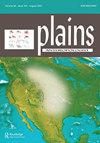When Dream Bear Sings: Native Literatures of the Southern Plains
Q2 Social Sciences
引用次数: 0
Abstract
When Dream Bear Sings edited by Gus Palmer, Jr. is an ambitious volume that brings together the tribal stories, myths, folktales, and personal sketches and poems from multiple scholars and artists. The volume is organized by seven language families and a language isolate. Within these sections are individual works for each language family: one in Athabaskan, one in Kiowa-Tanoan, one in a language isolate (Tonkawa), two in Uto-Aztecan, four in Iroquoian, seven in Caddoan, nine in Siouan, and eleven in Algonquian. Some of the works have been previously published and are newly translated, and some stories are published for the first time. The introduction to the text comments on the cultural landscape of the Southern Great Plains, discussing the people that lived there before and after removal efforts. This edited volume includes works from both of these groups. The introduction also notes the importance of language survival and the noble efforts presented here to retain the original orthography. Much of the introduction discusses the controversies of translations, including the way that stories change when they are transcribed into another language. Additionally, oral narratives are indelibly changedwhen they are written in any language. Cultural context is also important when reading and interpreting the stories included in the book. Palmer notes that native knowledge has increased over the years with Pan-Indianmovements and language preservation programs. An ever-present challenge is accurately translating a work into another language and attempting to convey its meaning by getting to the “heart of things”. The Algonquian language family contains six different groups, Cheyenne with six stories and the other five (Absentee Shawnee, Kickapoo, Lenape, Miami, and Potawatomi) each with a single story. The Cheyenne section of the text begins with a Gordon Yellowman’s explanation of storytelling traditions and the appropriate time of day and season for each type of tale. “The Bear and the Coyote” is documented in Cheyenne and then translated into English by Joyce Twins. The other four stories were told by Birdie Burns of the Cheyenne tribe and discuss ancient lifeways of the Cheyenne. The Absentee Shawnee chapter written by the editor includes a brief background on the language and a pronunciation guide. The short poems in this section were written by Pauline Wahpepah, a native speaker and teacher, and are entitled Eagle, Bear, Sun, and Flower. The selection for the Kickapoo language byMosiah Bluecloud is from a story discovered in the basement of the Kickapoo Secondary Administration Building in McCloud, Oklahoma. The tale is about motorcyclists harassing an Indian man at a diner and the man gets his revenge. The Lenape section contains background on the language as well as a map on the tribe’s removal. The story about the origin of the woman dance is recorded in Lenape and English. An interesting addition in this chapter is a link that directs readers to the original recordings of Lenape stories. David Costa provides a detailed background on the Miami language and the narrator (Kiišikohkwa, or Elizabeth Valley). The Miami section concludes with the “Story of Fox and Wolf”. The Potawatomi selection introduced and transcribed by Justin Neely tells of the origin of spring. plains anthropologist, Vol. 66 No. 258, May 2021, 172–174当梦熊歌唱:南方平原的乡土文学
小古斯·帕尔默主编的《当梦熊歌唱》是一本雄心勃勃的书,汇集了部落故事、神话、民间故事、多位学者和艺术家的个人素描和诗歌。该卷由七个语系和一个语言隔离区组成。在这些章节中,每个语系都有单独的作品:一部在阿萨巴斯卡语,一部在基奥瓦-塔诺安语,一个在语言隔离区(通川语),两部在乌托阿兹特克语,四部在易洛魁语,七部在加多安语,九部在苏安语,十一部在阿尔冈基语。其中一些作品之前已经出版并被新翻译,还有一些故事是首次出版。正文引言评述了南方大平原的文化景观,论述了人们在迁移前后的努力。这本经过编辑的卷包括这两个小组的作品。引言还指出了语言生存的重要性,以及为保留原始正字法所做的崇高努力。引言的大部分内容都讨论了翻译的争议,包括故事被转录成另一种语言时的变化方式。此外,口头叙述在用任何语言书写时都会发生不可磨灭的变化。在阅读和解读书中的故事时,文化背景也很重要。帕尔默指出,随着泛印度运动和语言保护计划的实施,本土知识近年来有所增加。一个永远存在的挑战是将一件作品准确地翻译成另一种语言,并试图通过触及“事物的核心”来传达其含义。阿尔冈基语系包含六个不同的族群,夏安语有六个故事,其他五个族群(Absentee Shawnee、Kickapoo、Lenape、Miami和Potawatomi)各有一个故事。文本的夏安部分以戈登·耶洛曼对讲故事传统的解释以及每种类型故事的适当时间和季节开始。《熊与狼》在夏延有记载,随后由乔伊斯·特温翻译成英文。另外四个故事由夏延族的伯迪·伯恩斯讲述,并讨论了夏延族古老的生活方式。编辑撰写的《缺席的肖尼》一章包括一个简短的语言背景和发音指南。本节中的短诗由母语为波林·瓦佩帕的教师创作,题为《鹰、熊、太阳和花》。Mosiah Bluecloud对Kickapoo语言的选择来自于在俄克拉荷马州麦克劳德市KickapooSecondary Administration大楼地下室发现的一个故事。这个故事是关于摩托车手在一家餐馆骚扰一名印度男子,该男子得到了报复。Lenape部分包含语言背景以及部落迁移地图。关于女子舞蹈起源的故事用勒纳佩语和英语记载。本章中一个有趣的补充是一个链接,引导读者阅读Lenape故事的原始录音。David Costa提供了迈阿密语言的详细背景和叙述者(Kiišikohkwa,或Elizabeth Valley)。迈阿密部分以“狐狸和狼的故事”结尾。Justin Neely引入并转录的Potawatomi选集告诉了春天的起源。平原人类学家,第66卷第258期,2021年5月,172–174
本文章由计算机程序翻译,如有差异,请以英文原文为准。
求助全文
约1分钟内获得全文
求助全文

 求助内容:
求助内容: 应助结果提醒方式:
应助结果提醒方式:


